Lumbini Tour
Lumbini Tour
“Lumbini, the birthplace of Lord Buddha and a UNESCO World Heritage Site, attracts over 400,000 Buddhist and non-Buddhist pilgrims annually to its Sacred Garden, where a commemorative pillar erected by Mauryan Emperor Ashoka marks the exact spot where the Buddha was born in 623 BC, with the sacred Puskarni Pond and monastic zones of various countries depicting different sects of Buddhism, such as the Myanmar Temple, the International Gautami Nuns Temple, the China Temple, the Dae Sung Suk Ga Sa Korean Temple, and the Japan Peace Stupa, which is a 41-meter tall structure with four different Buddha statues facing the four cardinal directions.”
Lumbini, located in the southwestern part of Nepal, is the birthplace of Siddhartha Gautama, who later became known as the Buddha. It is one of the most important pilgrimage sites for Buddhists worldwide, with over 400,000 visitors every year, both Buddhists and non-Buddhists alike. In recognition of its cultural and spiritual importance, Lumbini is listed as a UNESCO World Heritage Site.
The Sacred Garden is the heart of Lumbini, where the Buddha was born in 623 BC. A commemorative pillar, erected by the Indian Emperor Ashoka during his visit to the site in 249 BC, marks the spot where the Buddha was born. The garden covers an area of 9 square kilometers and includes the Maya Devi Temple, which is dedicated to the Buddha’s mother. The temple features a stone sculpture of the Buddha’s birth, with Maya Devi holding onto a branch of a tree while giving birth to Siddhartha.
The Puskarni Pond is another important site in the Sacred Garden. It is believed that Queen Maya Devi, before giving birth to the Buddha, took a bath in this pond. It was also where the infant Buddha was given his first bath. The pond is still present in the garden and is considered sacred by visitors, who often bathe in the waters for spiritual purification.
To the north of the Sacred Garden lies the monastic zone, where different countries have built temples and monasteries to represent their particular sects of Buddhism. These temples and monasteries are architecturally stunning and are often adorned with intricate carvings and paintings. The Myanmar Temple is a standout structure with its shiny gold and white exterior that resembles the famous Shwedagon Pagoda in Yangon. The International Gautami Nuns Temple is a replica of the Swayambhu Stupa in Kathmandu, while the China Temple features a complex of pagodas, prayer rooms, and meditation cells. Across the road, the Dae Sung Suk Ga Sa Korean Temple is a prominent landmark with its traditional Korean architecture.
The Japan Peace Stupa is another highlight of the monastic zone, built by the Nippon Jon Kyohoji of Japan. It is a 41-meter-tall structure with four different Buddha statues set into the stupa’s dome, facing the four cardinal directions. Other countries that have built beautiful monuments and temples in Lumbini include Vietnam, Thailand, Mongolia, France, Germany, and Sri Lanka.
Given the vast expanse of the Sacred Garden and the many monasteries and temples to explore, it is recommended to spend at least three days in Lumbini to fully experience the spiritual and cultural significance of the site.












